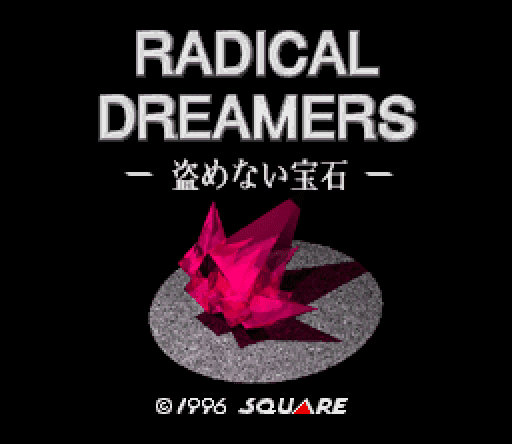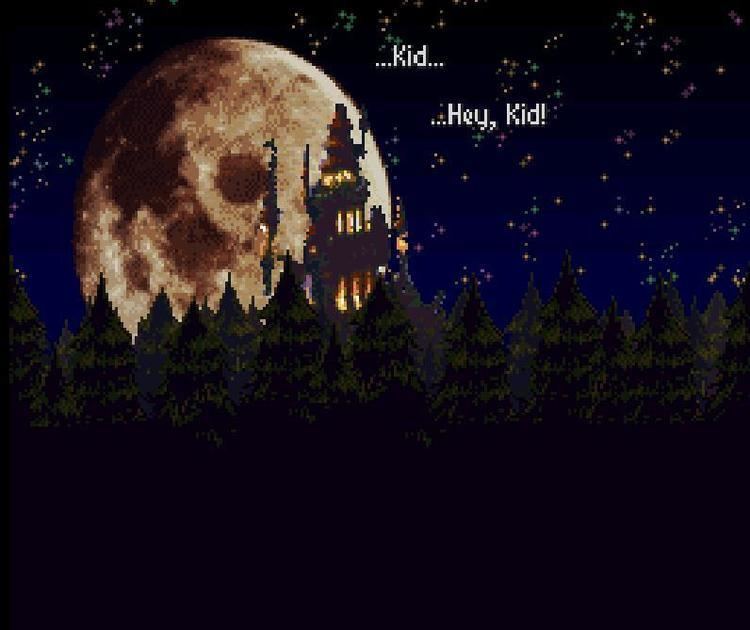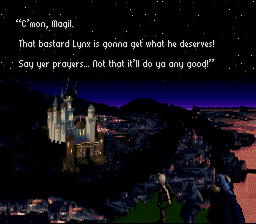9.2 /10 1 Votes9.2
Mode(s) Single-player Publisher Square | 4.6/5 Emuparadise Artist(s) Yasuhiko Kamata Genre(s) Visual novel Initial release date 3 February 1996 Developer Square | |||||||||||||||||||||||||||||||||
 | ||||||||||||||||||||||||||||||||||
Writer(s) Masato KatoMakoto ShimamotoTakashi TanegashimaDaisuke FukugawaMiwa Shoda Platform Super Nintendo Entertainment System Similar Chrono games, Square games, Adventure games | ||||||||||||||||||||||||||||||||||
Chrono cross radical dreamers classical guitar
Radical Dreamers: Nusumenai Hōseki (Japanese: ラジカル・ドリーマーズ -盗めない宝石-, "Radical Dreamers: The Unstealable Jewel") is a Japanese video game developed by Square in 1996 for the Satellaview add-on for the Super Famicom. It is a text-based visual novel in which the player takes the role of Serge, a young adventurer accompanied by Kid, a teen-aged thief, and Gil, a mysterious masked magician.
Contents
- Chrono cross radical dreamers classical guitar
- Chrono cross radical dreamers nusumenai h seki piano
- Gameplay
- Characters and story
- Development
- Music
- Fan translation
- References

The game belongs to the Chrono series and is a gaiden, or side story, to the 1995 game Chrono Trigger. It was released to complement its predecessor's plot, and later served as inspiration for Chrono Cross. It features text-based gameplay with minimal graphics and sound effects, and was scored by composer Yasunori Mitsuda. Unlike many Satellaview titles, Radical Dreamers was not designed to lock after a certain number of playthroughs, so players owning an 8M Memory Pack onto which the game was downloaded can still play today.

Square tried to integrate Radical Dreamers into the Japanese PlayStation port of Chrono Trigger as an Easter egg. Writer and director Masato Kato halted this and other releases, unhappy with the quality of his work. Though the game was never officially released abroad, ROM hackers completed an English fan translation in 2003.

Chrono cross radical dreamers nusumenai h seki piano
Gameplay

Gameplay consists of word-based scenarios presented to the player through the narration of the main character, Serge. As the narrative progresses, the game presents a list of possible actions and the player must choose his or her course. Depending on the choices made, the player may enter a new area, be presented with a new situation or character, or have to choose again if the previous selection was incorrect. In combat with enemies, the player must select from options such as "Fight", "Magic", "Run", and often more complex situational commands like "Run my knife into the goblin's chest!" or "Quickly slash at its hand!". Some decisions must be made before an invisible timer runs out; in combat, hesitation results in injury or death. Serge's health is tracked by an invisible point count, restored by various events (such as finding a potion). The game also tracks Kid's affection for Serge, influenced by battles and scripted events. Her feelings determine whether Serge survives the story's climactic fight.

Radical Dreamers features minimal graphics and animation; most areas are rendered with dim, static backgrounds. The game also uses atmospheric music and sounds. Like other Chrono games, Radical Dreamers contains a variant of New Game + mode. Only one scenario is available on the first play-through; after finishing it and obtaining one of three possible endings, players can explore six others. These later stories often feature comical situations or allusions to Chrono Trigger.
Characters and story
Radical Dreamers features three protagonists—Serge, Kid, and Magil—who seek out treasure as venturesome, reputable thieves. The young adult narrator, Serge, is a drifting musician who met Kid by chance three years ago in a remote town. Serge enjoys adventure with a carefree attitude. Kid, only sixteen years old, is a renowned professional thief with a reputation for boisterous behavior. Possessing a turbulent history, Kid dubiously fancies herself as a kind of Robin Hood. Magil is an enigmatic, handsome masked man skilled in magic who rarely speaks and can fade into shadow at will. Crowned by flowing, blue hair, Magil accompanied Kid well before Serge joined the group. They seek the Frozen Flame, a mythic artifact capable of granting any wish. It is hidden in Viper Manor—the home of a terrible and powerful aristocrat named Lynx, who gained control of the estate after usurping power from and killing the Acacia Dragoons, a familial unit of warriors.
Following Kid, the group infiltrates Viper Manor on the night of a full moon. While sneaking through the corridors, they battle goblins and other creatures of legend while unraveling the history of the manor and its occupants. Magil explains that the Frozen Flame is a fragment of the massive, extraterrestrial creature known as Lavos, splintered off when Lavos impacted the planet in prehistory and burrowed to its core. The thieves locate Lynx and the Frozen Flame deep within an underground ruin of the Kingdom of Zeal—an ancient, airborne civilization destroyed after it awakened Lavos in search of immortality. Serge discovers that Kid is an orphan, hoping to exact revenge upon Lynx for killing her caretaker, Lucca. Kid attempted to find Lynx in her childhood after Lucca's death, but was stopped and saved from certain defeat by Magil, who accompanied her thereafter.
The trio battle Lynx for the Frozen Flame, and Lynx gains the upper hand after trapping Magil with a powerful spell. He plans to acquire Kid's special gift from Lucca—a Time Egg, or Chrono Trigger. With a Time Egg and the Frozen Flame, Lynx boasts that he shall achieve control over time. Kid lunges at him, but Lynx easily parries her attack and wounds her. She desperately removes the Chrono Trigger from her back pocket. The Trigger shatters and causes a localized temporal distortion, leading Serge to see various scenes in history. Kid learns of her heritage as princess Schala of Zeal, a meek girl who was coerced to help awaken Lavos with her magical power. As Zeal collapsed, Schala was wracked with anguish and guilt for her role in the incident. Nearby in the Ocean Palace, the Frozen Flame felt her grief and changed her to a baby, sending her to the modern era where Lucca found her. It is also circumstantially revealed that Magil is in fact Magus, Schala's wayward brother who searched for her after battling Lavos in Chrono Trigger. Once the distortion subsides, an army from Porre—a large nation in search of the Frozen Flame—storms the mansion. Lynx withdraws as Kid, Serge, and Magil flee. Kid tells Serge that she is aware of her true origin, and knowing that is a treasure which cannot be stolen. She bids him goodbye before disappearing into the darkness with Magil.
Other scenarios are available after players complete the first. These include both humorous and serious variations of the main plot.
Development
Masato Kato wrote Radical Dreamers after Chrono Trigger's release, feeling that Trigger concluded with "unfinished business". He composed the main story and drafted the concepts for the sub-scenarios, leaving them to be completed by his peers. He allowed Makoto Shimamoto to write the entire "Kid and the Sunflower" segment, later joking that he "avoided having any part in that episode," while Miwa Shoda was in charge of the "Shadow Realm and the Goddess of Death" segment. According to scenario writer Daisuke Fukugawa (responsible for the game's "The Enigmatic Gigaweapon: Paradise X" subplot), the game's graphical content pushed the Satellaview's technical limits, requiring developers to redraw prerendered models until functional gameplay could be ensured. Kato remarked that his "savage feelings" from Chrono Trigger's hectic development manifested in Kid's "unusually nihilistic attitude". He explained his approach towards the project in 1999:
...due to the fact that this was a text-based game, the contents of the game ended up being rather serious and emotional. The game itself was a real life-or-death kind of survival adventure game. I think there was a feeling somewhere deep in my heart that said, 'I wanna try making a horror game!' But soon after that, they came out with Biohazard, so I quickly got over that phase (laughs).
...the comical sub-scenarios were written to be extremely comical beyond any measurement, so I think it sorta' balances out...But I can say that since this game wasn't expected to be widely sold on the market, and also since there wasn't any profit on our part, there was a feeling that I wanted to make this game out of my sole interest. In a way, I think that 'Radical' helped me to find my own path...But then again, I guess you could say that I strayed away from the paths of normal people.
Kato's team completed Radical Dreamers in only three months under a rushed production schedule, prompting him to label the game "unfinished" in an interview for the Ultimania Chrono Cross guide. Kato regretted that the schedule hampered the quality of his work, and explained that the connections to Chrono Trigger were evoked towards the end of the project:
When I originally started working on Radical Dreamers, I never thought that it would have such an ending. We only had three months for development, and I was just making up the story while inputting data. When I finally realized the connection of the identities of Kid and Magil near the final stage of development, I even amazed myself, saying, 'So, that's who they were!?' (laughs) Also, since there were issues with the media, the connections between Radical Dreamers and Chrono Trigger were intentionally left blurred in the background so that it'd only be recognizable by those who would understand.
Music
The music of Radical Dreamers was written by composer Yasunori Mitsuda, who scored Chrono Trigger and later Chrono Cross. The soundtrack includes several ambient pieces, including the sound of water running in a fountain and wind accompanied by strings. Players can listen to the game's songs by accessing a hidden menu in the "Gil: Caught Between Love and Adventure" scenario. Several themes and musical patterns were later adapted for Chrono Cross on the suggestion of director Masato Kato; many appear unchanged except for new instrumentation.
Fan translation
In April 2003, the ROM hacking group Demiforce released a fan translation rendering Radical Dreamers in English. The patch works by modifying the ROM image of Dreamers used for playing console-based video games on personal computers through emulation. The ability to save games was not enabled with the first patch, and some minor typos were left in, later remedied by successive releases. On Christmas Day 2005, Demiforce and Radical R released the final version (1.4) of the translation, which fixed remaining minor bugs. The French team Terminus Traduction made a French translation patch soon after. Masato Kato did not perceive significant demand to include Radical Dreamers as a bonus with the release of Chrono Trigger DS, and omitted it to preserve continuity between Trigger and Cross. He expressed concern in 2009 over re-releasing Radical Dreamers "as-is", citing a need to revise the work.
A reviewer for Home of the Underdogs lauded the game's excellent writing and the "superb" English translation patch, noting that the "interesting plot" would appeal to fantasy fans if they could stomach the limited interactivity. Having never played a Chrono game prior, the reviewer stated, "I was still able to follow the story and be drawn into the world of colorful characters." While praising the replay value afforded by the extra scenarios, the critic derided the random battles of Radical Dreamers, writing that "RPG-style random combat doesn't translate well to [a] text-only medium." The website awarded Dreamers "Top Dog" status, and the game maintains a voter score of 8.95 out of 10.
Radical Dreamers preceded Chrono Cross, a full role-playing video game sequel to Chrono Trigger. Masato Kato cited the desire to "redo Radical Dreamers properly" as the genesis of Cross, attributing the latter's serious atmosphere to the influence of Dreamers. Kato's desire to finish the story of the characters Kid and Serge principally shaped the plot of Cross. Chrono Cross borrowed certain thematic elements, story points, characters, music, and objects introduced in Radical Dreamers—including the infiltration of Viper Manor, the Frozen Flame, the name Radical Dreamers for Kid's thievery, and the characters of Kid, Lynx, and Serge (who became a non-speaking protagonist). Though these characters and items were not presented in the same context, their general traits survived the transition. Gil, confirmed by Kato to be Magus, was also going to be featured in Chrono Cross. This idea was scrapped due to difficulties in representing the story of Magus among the game's numerous other characters; the unrelated, enigmatic magician Guile was created instead. Since the release of Chrono Cross, Radical Dreamers is considered an alternate continuity of the Chrono series. Chrono Cross addressed this through an easter egg hinting that Radical Dreamers took place in a different dimension. In the English version of Chrono Cross, this easter egg refers to Gil as "Magil". Kato intended Dreamers and Cross to prompt players to pursue their personal dreams in life.
